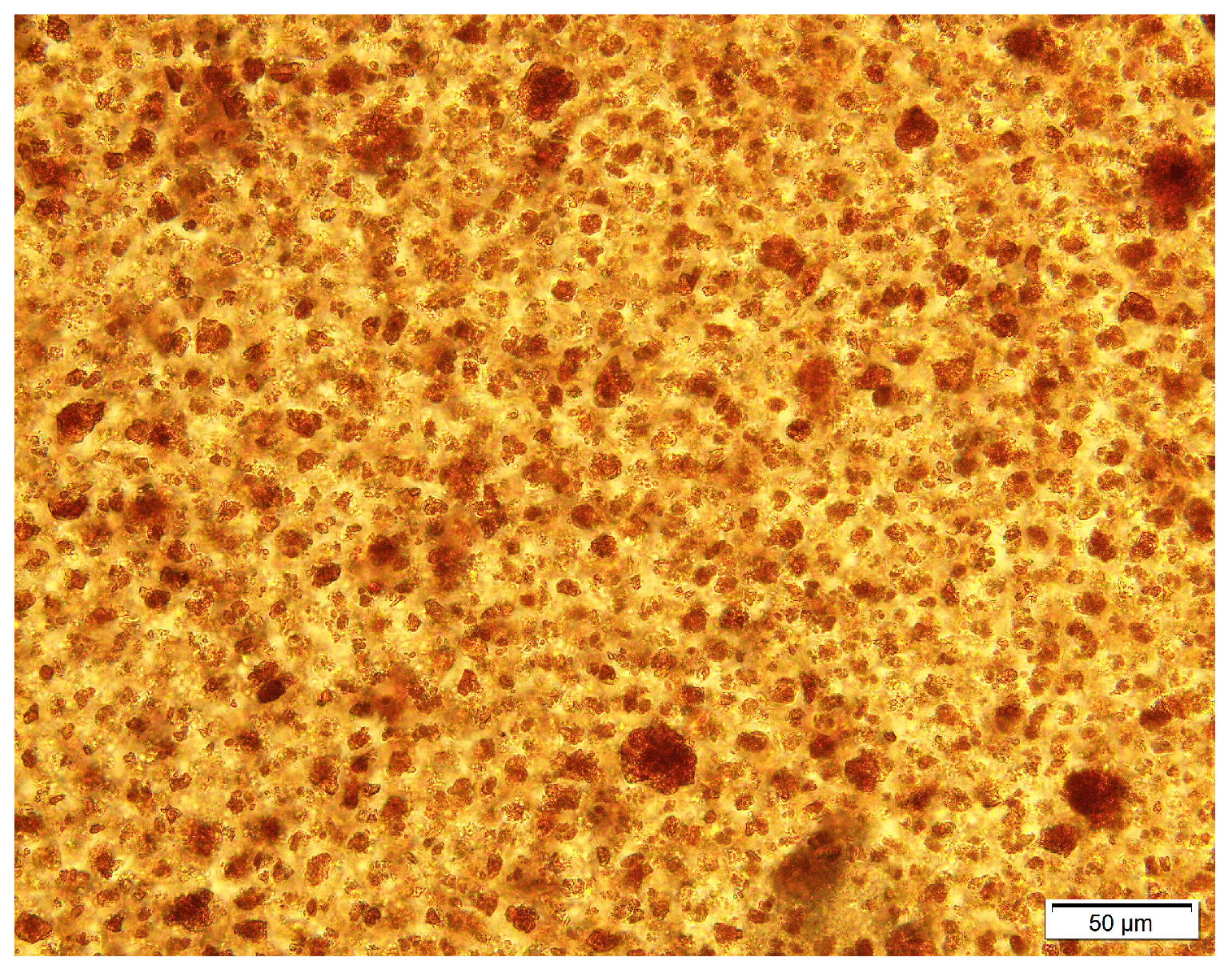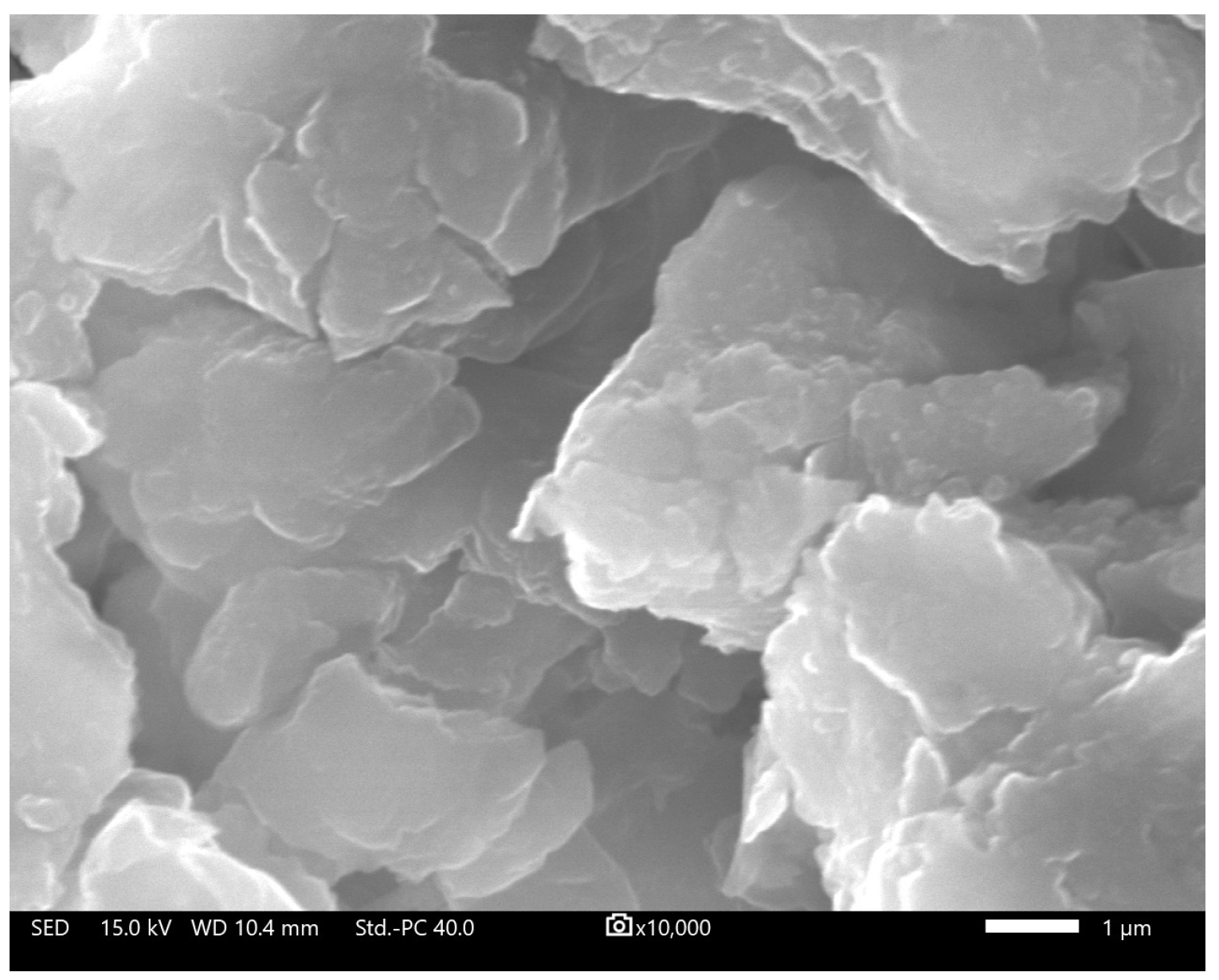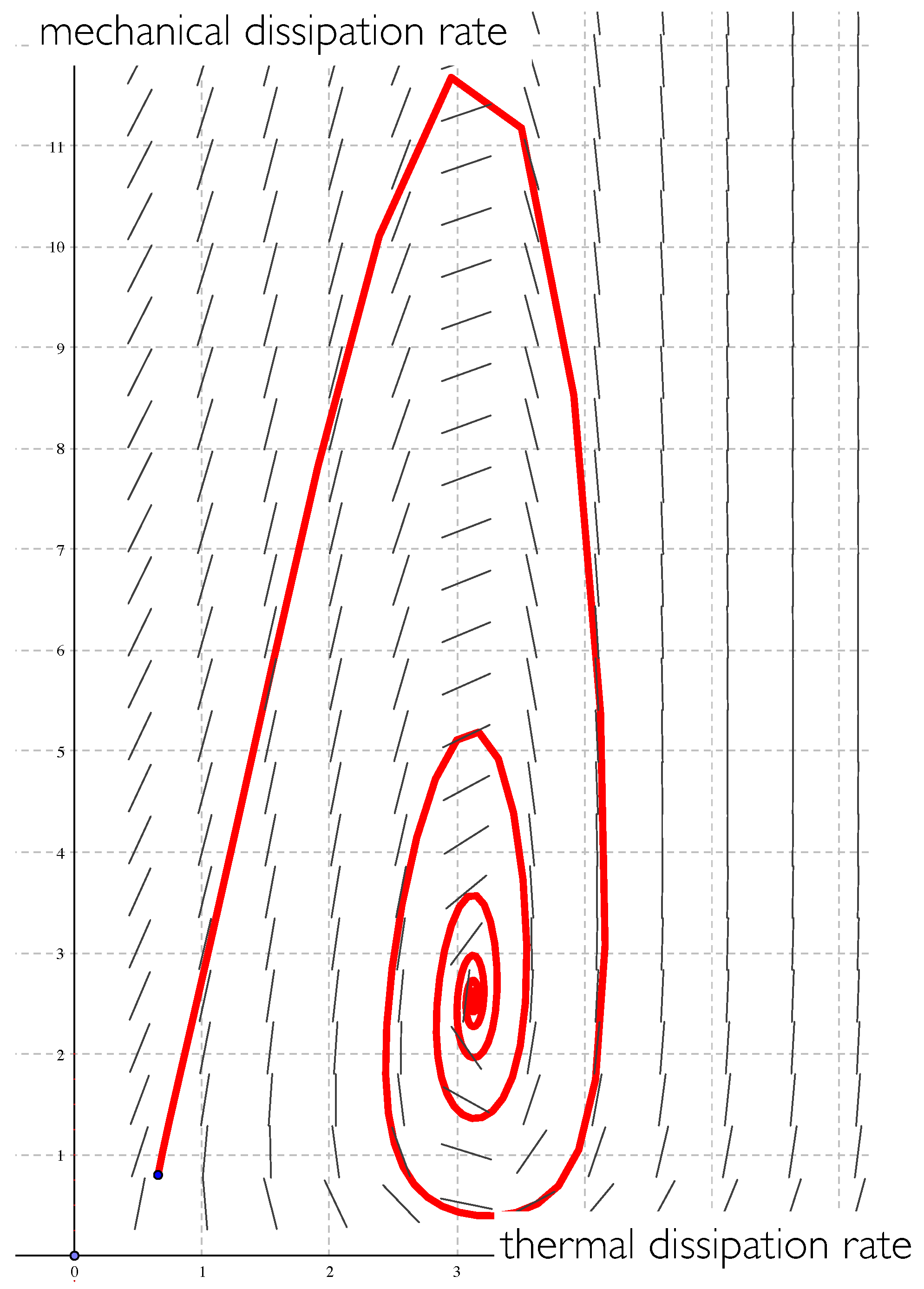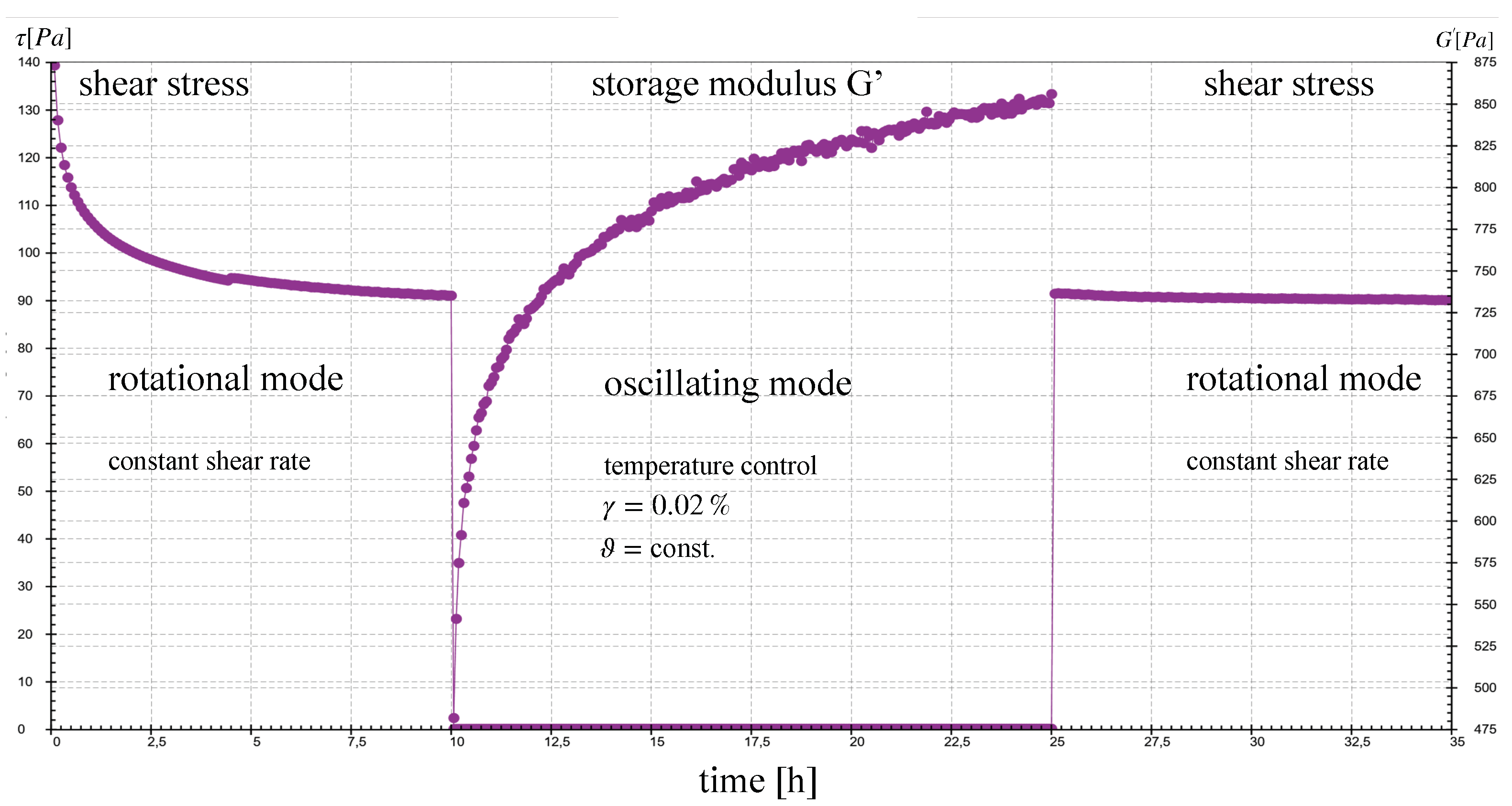Some Considerations to the Energy Dissipation of Frictionally Stressed Lubricating Greases
Abstract
1. Introduction
2. Lubricating Greases
3. Checking the Stability of the System
3.1. The Investigations to Date
- Mechanical dissipation (fragmentation) always runs in parallel with thermal dissipation ;
- The energy dissipation rate is influenced by the amount of energy that is applied to the system ;
- There is an influence of energy dissipated up until now;
- The energy dissipation rate changes relative with the energy dissipated in the mechanism i in relation to the energy dissipated in j and k (mechanical dissipation – coagulation).
3.2. Investigation with Extended Dependencies
4. Thixotropic Effects from the Perspective of the Observations Made
- Hydrogen bonds (binding OH groups) between lithium soap fibers are destroyed when grease is sheared;
- The observations indicate that the hydrocarbon chains of individual fibers become joined during the flow of grease;
- After the shear process, investigations have shown that hydrogen bonds destroyed during shearing form again. In addition, the number of COOH groups was found to decrease, which indicates a change in the chain structure of floccules.
- Macroscale: Continuum material characterized by macroscopic properties, such as storage modulus , apparent viscosity , etc., corresponding to instantaneous network structures.
- Mesoscale: Determined by network shape, i.e., arrangement and geometry. Structure formation increases the degree of order.
- Nanoscale: Characterized by the interaction of free chain ends. Energy is bound and the energetic state of the system is minimized. Entropy production can lead to instability.
- -
- Thermodynamix force ;
- -
- Structure formation velocity ;
- -
- Content of solids ;
- -
- Portion of new interactions ;
- -
- Number of free ends N;
- -
- Portion of free ends without interactions ;
- -
- Temperature T;
- -
- Distance to equilibrium .
5. Results
Funding
Data Availability Statement
Conflicts of Interest
Nomenclature
| mechanical dissipation [J] | |
| the reduction caused by wear [J] | |
| thermal dissipation [J] | |
| amount of energy that is applied [J] | |
| friction energy [J] | |
| fragmentation rate | |
| J | thermodynamic flux |
| N | number of free ends |
| portion of free ends without interactions | |
| portion of new interactions | |
| S | entropy [] |
| entropy production [] | |
| T | temperature [K] |
| V | volume [] |
| X | thermodynamic force |
| distance to from the equilibrium | |
| structure formation velocity | |
| heat conductivity [] | |
| deformation | |
| content of solids | |
| shear rate [] | |
| shear stress [Pa] | |
| density [] |
References
- Bartz, W.J. Lubricating Greases, 2nd ed.; Expert Verlag: Tuebingen, Germany, 2015. (In German) [Google Scholar]
- Zhou, Y.; Bosman, R.; Lugt, P.M. A master curve for the shear degradation of lubricating greases with a fibrous structure. Tribol. Trans. 2019, 62, 78–87. [Google Scholar] [CrossRef]
- Zhou, Y.; Bosman, R.; Lugt, P.M. A model for shear degradation of lithium soap grease at ambient temperature. Tribol. Trans. 2018, 61, 61–70. [Google Scholar] [CrossRef]
- Rezasoltani, A.; Khonsari, M. On the correlation between mechanical degradation of lubricating greases and entropy. Tribol. Lett. 2014, 56, 197–204. [Google Scholar] [CrossRef]
- Prigogine, I. Vom Sein zum Werden- Zeit und Komplexitaet in den Naturwissenschaften; Piper-Verlag: Munich, Germany, 1980. [Google Scholar]
- Prigogine, I. Dissipative structures in biological systems. In Proceedings of the 2nd International Conference on Theoretical Physics and Biology, Versailles, France, 30 June–5 July 1969; Editions du Centre National de la Recherche Scientifique: Paris, France, 1969. [Google Scholar]
- Gershman, I.S.; Mironov, A.E.; Gershman, E.I.; Fox-Rabinovich, G.S.; Veldhuis, C. Self-organisation during friction of sliding bearing antifriction materials. Entropy 2015, 17, 7967–7978. [Google Scholar] [CrossRef]
- Gershman, I.; Gershman, E.I.; Mironov, A.E.; Fox-Rabinovich, G.; Veldhuis, S. Application of the self-organization phenomenon in the development of wear resistant materials—A review. Entropy 2016, 18, 385. [Google Scholar] [CrossRef]
- Nosonovsky, M.; Bhushan, B. Surface-self-organization: From wear to self-healing in biological and technical surfaces. Appl. Surf. Sci. 2010, 256, 3982–3987. [Google Scholar] [CrossRef]
- De Groot, S.R.; Mazur, P. Basics of Thermodynamic of Irreversible Processes; Bibliographisches Institut: Mannheim, Germany, 1984; ISBN 978-341001620. [Google Scholar]
- Kuhn, E. Aspects of Self-Organization of Tribological Stressed Lubricating Greases. Lubricants 2020, 8, 28. [Google Scholar] [CrossRef]
- Klamecki, B.E. Energy dissipation in sliding. Wear 1982, 77, 115–128. [Google Scholar] [CrossRef]
- Kuhn, E. Energy Dissipation in Tribological Stressed Greases. Processes 2024, 12, 17. [Google Scholar] [CrossRef]
- Jetschke, G. Mathematic of Selforganisation; Vieweg: Braunschweig, Germany, 1989. (In German) [Google Scholar]
- Freundlich, H. About thixotropy. Kolloid-Zeitschrift 1928, 46, 289–299. (In German) [Google Scholar] [CrossRef]
- Czarny, R. Effect of changes in grease structure on sliding friction. Ind. Lubr. Tribol. 1995, 47, 3–7. [Google Scholar] [CrossRef]
- Czarny, R. Influence of thixotropic on the rheological properties of lubricating greases. Tribol. Schmierungstech. 1989, 3, 134–140. (In German) [Google Scholar]
- Paszkowski, M.; Olsztynska-Janus, S. Research on the kinetics of lithium grease thixotropic microstructure reconstruction. In Proceedings of the World Tribology Conference, Turin, Italy, 8–13 September 2013. [Google Scholar]
- Paszkowski, M.; Olsztynska-Janus, S. Grease thixotropy: Evaluation of grease microstructure change due to shear and relaxation. Ind. Lubr. Tribol. 2014, 66, 223–237. [Google Scholar] [CrossRef]
- Gershman, J.S.; Gershman, E.I.; Fox-Rabinovich, G.S.; Veldhuisen, S. Description of seizur process for gas dynamic spray of metal powders from non-equilibrium thermodynamic standpoint. Entropy 2016, 18, 315. [Google Scholar] [CrossRef]




Disclaimer/Publisher’s Note: The statements, opinions and data contained in all publications are solely those of the individual author(s) and contributor(s) and not of MDPI and/or the editor(s). MDPI and/or the editor(s) disclaim responsibility for any injury to people or property resulting from any ideas, methods, instructions or products referred to in the content. |
© 2025 by the author. Licensee MDPI, Basel, Switzerland. This article is an open access article distributed under the terms and conditions of the Creative Commons Attribution (CC BY) license (https://creativecommons.org/licenses/by/4.0/).
Share and Cite
Kuhn, E. Some Considerations to the Energy Dissipation of Frictionally Stressed Lubricating Greases. Lubricants 2025, 13, 86. https://doi.org/10.3390/lubricants13020086
Kuhn E. Some Considerations to the Energy Dissipation of Frictionally Stressed Lubricating Greases. Lubricants. 2025; 13(2):86. https://doi.org/10.3390/lubricants13020086
Chicago/Turabian StyleKuhn, Erik. 2025. "Some Considerations to the Energy Dissipation of Frictionally Stressed Lubricating Greases" Lubricants 13, no. 2: 86. https://doi.org/10.3390/lubricants13020086
APA StyleKuhn, E. (2025). Some Considerations to the Energy Dissipation of Frictionally Stressed Lubricating Greases. Lubricants, 13(2), 86. https://doi.org/10.3390/lubricants13020086




